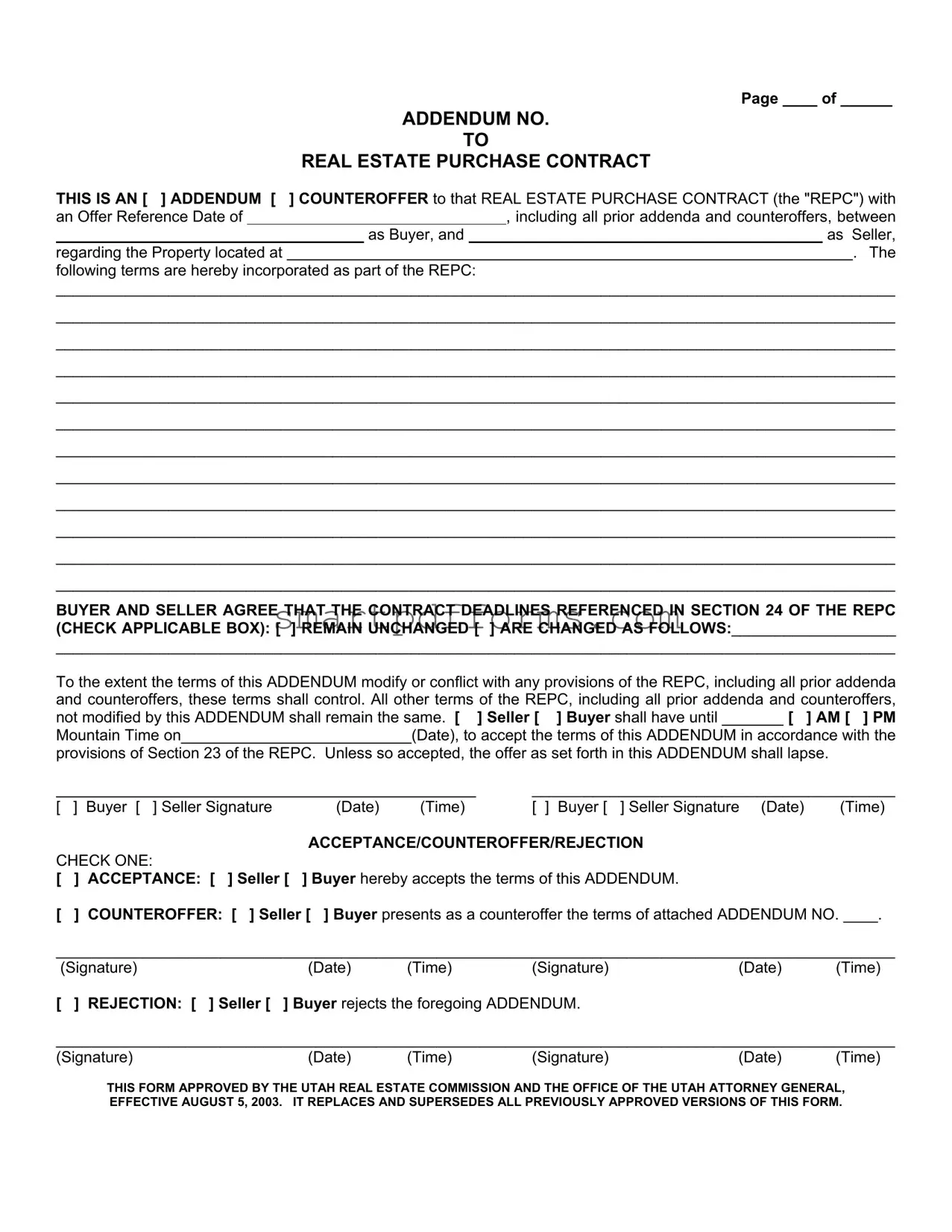|
|
|
|
|
|
Page ____ of ______ |
|
|
|
ADDENDUM NO. |
|
|
|
|
|
|
TO |
|
|
|
|
|
REAL ESTATE PURCHASE CONTRACT |
|
|
|
THIS IS AN [ ] ADDENDUM [ |
] COUNTEROFFER to that REAL ESTATE PURCHASE CONTRACT (the "REPC") with |
an Offer Reference Date of |
|
|
|
|
, including all prior addenda and counteroffers, between |
|
|
|
as Buyer, and |
|
as Seller, |
regarding the Property located at |
|
|
|
|
|
|
. The |
following terms are hereby incorporated as part of the REPC:
_________________________________________________________________________________________________
_________________________________________________________________________________________________
_________________________________________________________________________________________________
_________________________________________________________________________________________________
_________________________________________________________________________________________________
_________________________________________________________________________________________________
_________________________________________________________________________________________________
_________________________________________________________________________________________________
_________________________________________________________________________________________________
_________________________________________________________________________________________________
_________________________________________________________________________________________________
_________________________________________________________________________________________________
BUYER AND SELLER AGREE THAT THE CONTRACT DEADLINES REFERENCED IN SECTION 24 OF THE REPC (CHECK APPLICABLE BOX): [ ] REMAIN UNCHANGED [ ] ARE CHANGED AS FOLLOWS:___________________
_________________________________________________________________________________________________
To the extent the terms of this ADDENDUM modify or conflict with any provisions of the REPC, including all prior addenda and counteroffers, these terms shall control. All other terms of the REPC, including all prior addenda and counteroffers,
not modified by this ADDENDUM shall remain the same. [ |
] Seller [ ] Buyer shall have until |
|
|
[ |
] AM [ ] PM |
Mountain Time on |
|
|
(Date), to accept the terms of this ADDENDUM in accordance with the |
provisions of Section 23 of the REPC. Unless so accepted, the offer as set forth in this ADDENDUM shall lapse. |
|
|
|
|
__________________________________________ |
[ ] Buyer [ ] Seller Signature |
(Date) |
(Time) |
[ ] Buyer [ ] Seller Signature |
(Date) |
(Time) |
ACCEPTANCE/COUNTEROFFER/REJECTION
CHECK ONE:
[ ] ACCEPTANCE: [ ] Seller [ ] Buyer hereby accepts the terms of this ADDENDUM.
[ ] COUNTEROFFER: [ ] Seller [ ] Buyer presents as a counteroffer the terms of attached ADDENDUM NO. ____.
_________________________________________________________________________________________________
(Signature) |
(Date) |
(Time) |
(Signature) |
(Date) |
(Time) |
[] REJECTION: [ ] Seller [ ] Buyer rejects the foregoing ADDENDUM.
_________________________________________________________________________________________________
(Signature) |
(Date) |
(Time) |
(Signature) |
(Date) |
(Time) |
